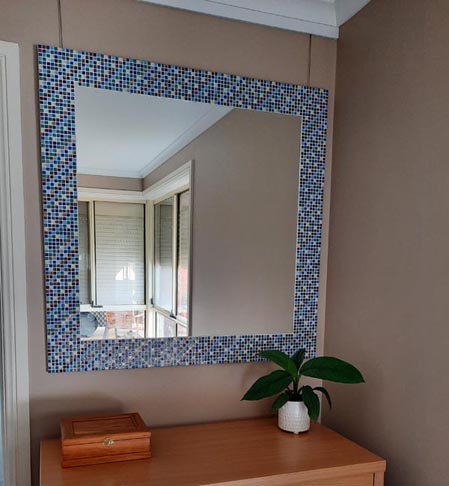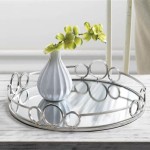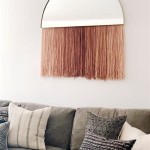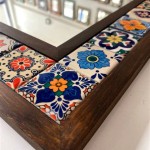How to Hang a Heavy Mirror on a Plaster Wall
Hanging a heavy mirror on a plaster wall presents a unique set of challenges compared to hanging it on drywall. Plaster, while often more durable than drywall, can be brittle and prone to cracking if not handled correctly. The weight of a heavy mirror, combined with the delicate nature of plaster, necessitates careful planning and the use of appropriate hardware and techniques. This article provides a comprehensive guide on how to safely and securely hang a heavy mirror on a plaster wall.
Before commencing the project, it is crucial to understand the composition and condition of the plaster. Plaster walls typically consist of multiple layers applied over lath, which can be wood or metal. Identifying the type of lath is important as it influences the selection of suitable anchors. Furthermore, assessing the plaster's overall condition for cracks, crumbling, or water damage is paramount. Addressing any pre-existing structural issues before hanging the mirror is vital to prevent further damage and ensure a secure installation.
Gather all necessary tools and materials before starting the installation. This includes a stud finder, level, measuring tape, pencil, drill with various drill bits (including a masonry bit if encountering brick or concrete behind the plaster), appropriate anchors for plaster walls, screws matching the anchors, safety glasses, dust mask, and a screwdriver. A helper can be invaluable for lifting and positioning the heavy mirror.
Identifying Wall Studs and Choosing the Right Anchors
Locating wall studs is the ideal scenario for hanging heavy items on any wall, including plaster. Studs provide the most robust support and minimize the risk of the mirror pulling away from the wall. Use a stud finder to accurately locate the studs behind the plaster. Stud finders detect changes in density, indicating the presence of a stud. Mark the stud locations with a pencil, verifying with a nail or small screw test to confirm the stud's presence. If a stud is located in the desired hanging position, select screws long enough to penetrate the plaster and wood stud by at least 1.5 inches. This ensures a secure hold.
If a stud is not accessible in the desired location, plaster-specific anchors are essential. Several types of anchors are suitable for plaster walls, each with its own weight capacity and installation method. Toggle bolts are a reliable choice for heavier mirrors. They consist of a bolt with a hinged "wing" that expands behind the wall, providing a strong and secure hold. Molly bolts are another option, featuring a metal sleeve that expands as the screw is tightened, gripping the back of the plaster. Self-drilling anchors, also known as wall anchors, are designed to be screwed directly into the plaster without pre-drilling. However, their weight capacity is generally lower than toggle bolts or molly bolts.
When choosing anchors, carefully consider the weight of the mirror and select anchors with a weight rating that exceeds the mirror's weight. It is advisable to overestimate the weight capacity to provide an extra margin of safety. Always refer to the manufacturer's instructions for the specific anchor being used, as installation methods and weight capacities can vary significantly.
Before installing any anchors, inspect the plaster for signs of weakness or crumbling. If the plaster is damaged, it may be necessary to reinforce the area with patching compound or install a backing board to provide a more solid surface for the anchors to grip.
Preparing the Wall and Installing the Anchors
Once the desired hanging location is determined and the appropriate anchors are selected, prepare the wall for installation. Use a level to ensure the mirror will hang straight. Mark the exact location for the anchor holes with a pencil. If using anchors that require pre-drilling, use a drill with a drill bit slightly smaller than the anchor's diameter. Drill slowly and carefully to avoid cracking or chipping the plaster. If encountering brick or concrete behind the plaster, switch to a masonry drill bit.
When drilling into plaster, it is beneficial to use a technique called "scoring." Before drilling the hole, use a utility knife or a sharp awl to score the plaster surface in a circular motion around the marked location. This helps to prevent the drill bit from wandering and minimizes the risk of chipping the plaster. After scoring, drill the hole slowly and steadily, applying gentle pressure. Avoid excessive force, as this can cause the plaster to crack or crumble. Clearing the dust from the hole periodically during drilling will facilitate the process and prevent the drill bit from overheating.
Insert the chosen anchors into the pre-drilled holes according to the manufacturer's instructions. For toggle bolts, fold the wings and insert the bolt through the mirror's hanging hardware and into the hole. Once the wings are behind the wall, they will spring open. Tighten the bolt to secure the mirror to the wall. For molly bolts, insert the bolt through the mirror's hanging hardware and into the anchor. As the bolt is tightened, the sleeve will expand behind the wall, gripping the plaster. For self-drilling anchors, simply screw the anchor directly into the plaster until flush with the wall surface.
Ensure that the anchors are properly seated and tightened according to the manufacturer's specifications. Over-tightening can damage the plaster, while under-tightening can compromise the anchor's holding power. After installing the anchors, test their stability by applying gentle pressure to the mirror's hanging hardware. If the anchors feel loose or unstable, remove them and reinstall them using a larger anchor or a different type of anchor.
Hanging the Mirror and Ensuring Stability
With the anchors securely installed, carefully lift the heavy mirror and align it with the mounted hardware. Ensure that the mirror is level and that the weight is evenly distributed between the anchors. If necessary, adjust the position of the mirror until it is perfectly level and aligned.
Once the mirror is in place, double-check the stability of the installation. Gently push and pull on the mirror to ensure that it is securely attached to the wall. If there is any movement or instability, remove the mirror and inspect the anchors. It may be necessary to reinforce the anchors with additional support or to use a different type of anchor with a higher weight capacity.
For added security, consider using safety wire or picture-hanging wire to connect the mirror to the wall studs. Attach one end of the wire to the mirror's hanging hardware and the other end to a screw secured into a wall stud. This provides an extra layer of protection against accidental falls. Alternatively, specialized mirror hanging systems can be used. These systems often employ multiple anchors and interlocking brackets to distribute the weight of the mirror evenly across the wall surface.
After the mirror is securely hung, visually inspect the surrounding plaster for any signs of stress or cracking. If any damage is observed, address it promptly to prevent further deterioration. Patching compound can be used to repair small cracks or chips. For larger areas of damage, it may be necessary to consult a professional plasterer.
Properly hanging a heavy mirror on a plaster wall requires careful planning, the selection of appropriate hardware, and meticulous installation techniques. By following these guidelines, individuals can safely and securely display their mirrors without damaging the plaster wall.

How To Hang A Large Or Heavy Mirror
:strip_icc()/ScreenShot2022-04-28at1.12.19PM-e055476c70c6438585fa7c5cd531edcf.png?strip=all)
4 Easy Ways To Hang A Heavy Mirror

How To Hang A Very Heavy Picture Or Mirror The Best
How To Hang A 100 Pound Mirror On Drywall Quora

A Better Way To Hang Heavy Mirror Hanging Pictures
Hanging Heavy Framed Mirrors Lath Plaster Walls The Picture Framers Grumble

How To Hang A Heavy Mirror On Drywall Stas Picture Hanging Systems

How To Hang A Heavy Mirror

How To Hang A Heavy Mirror

How To Hang A Heavy Mirror C R F T








